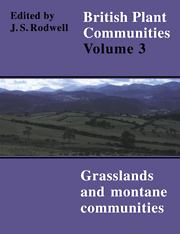Book contents
- Frontmatter
- Contents
- List of Figures
- Preface and Acknowledgements
- Preamble
- Mesotrophic Grasslands
- Community Descriptions
- Calcicolous Grasslands
- Community Descriptions
- Calcifugous Grasslands and Montane Communities
- Community Descriptions
- Index of Synonyms to Grasslands and Montane Communities
- Index of Species in Grasslands and Montane Communities
- Bibliography
U13 - Deschampsia Cespitosa-Galium Saxatile Grassland
Published online by Cambridge University Press: 04 July 2020
- Frontmatter
- Contents
- List of Figures
- Preface and Acknowledgements
- Preamble
- Mesotrophic Grasslands
- Community Descriptions
- Calcicolous Grasslands
- Community Descriptions
- Calcifugous Grasslands and Montane Communities
- Community Descriptions
- Index of Synonyms to Grasslands and Montane Communities
- Index of Species in Grasslands and Montane Communities
- Bibliography
Summary
Synonymy
Rhytidiadelphus-Deschampsia caespitosa nodum Poore & McVean 1957; Deschampsietum caespitosae alpinum McVean & Ratcliffe 1962 p.p.; Deschampsieto-Rhytidiadelphetum McVean & Ratcliffe 1962 p.p.; Deschampsia cespitosa-Rumex acetosa nodum Huntley 1979; Deschampsia cespitosa-Festuca rubra nodum Huntley 1979; Deschampsia cespitosa-Rhytidiadelphus loreus nodum Huntley 1979.
Constant species
Agrostis capillaris, Deschampsia cespitosa, Galium saxatile, Hylocomium splendens, Polytrichum alpinum, Rhytidiadelphus loreus.
Rare species
Cerastium arcticum, Minuartia sedoides, Sibbaldia procumbens.
Physiognomy
The Deschampsia cespitosa-Galium saxatile grassland comprises short or rather rank tussocky swards in which grasses and bulky hypnaceous mosses are the most important structural elements. The commonest and most abundant grass throughout is Deschampsia cespitosa and its coarse, densely-tufted habit often gives this vegetation its distinctive stamp. Sometimes, the plants are recognisably of ssp. alpina, which always has at least some proliferous spikelets, more or less smooth panicle branches and lemmas with a short awn set high on the back (Tutin et al. 1980, Hubbard 1984), but in Scotland this taxon is morphologically less well defined from ssp. cespitosa than in Scandinavia (Hedberg 1958). In some of the vegetation included here, D. cespitosa is so overwhelmingly dominant that little else can compete with its vigorous growth, but in general the swards are richer than this and a variety of other grasses often make a modest contribution to the cover. Most frequent among these are Agrostis capillaris, Festuca ovinalvivipara, Nardus stricta and Deschampsia flexuosa, with Anthoxanthum odoratum, Festuca rubra and Agrostis canina rather more unevenly distributed. Carex bigelowii is also quite common, though it does not usually have the abundance that it shows in the drier sedgeand moss-heaths with which this vegetation is often found. Luzula multiflora occurs occasionally and some stands have a little L. sylvatica, a plant which can increase its contribution very substantially where the Deschampsia-Galium grassland grades to the vegetation of ungrazed ledges.
Other herbs have a rather variable representation and, among these, only Galium saxatile is constant throughout. But Rumex acetosa, Alchemilla alpina and Viola palustris are very common and characteristic and there are occasional records for Potentilla erecta, Oxalis acetosella, Cerastium fontanum, Euphrasia frigida and Huperzia selago, with Sibbaldiaprocumbens, Ranunculus acris, Diphasium alpinum, Saxifraga stellaris and Thymus praecox sometimes occurring in the more diverse of the grassy swards.
- Type
- Chapter
- Information
- British Plant Communities , pp. 430 - 439Publisher: Cambridge University PressPrint publication year: 1992

